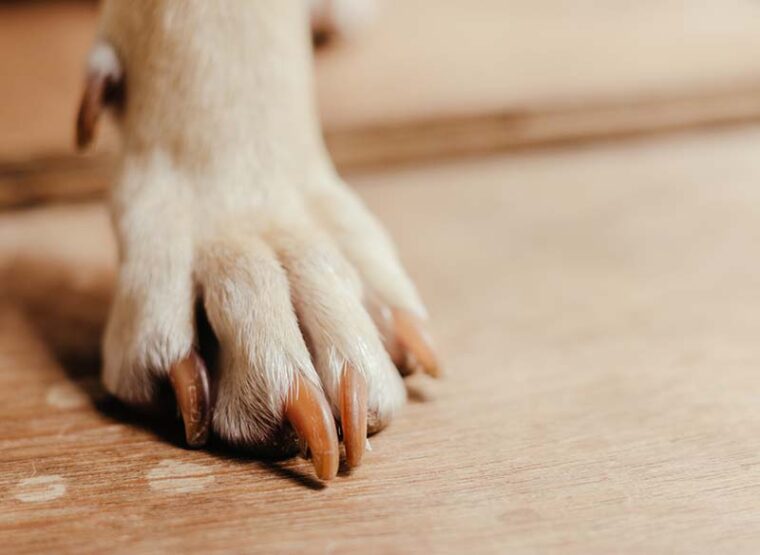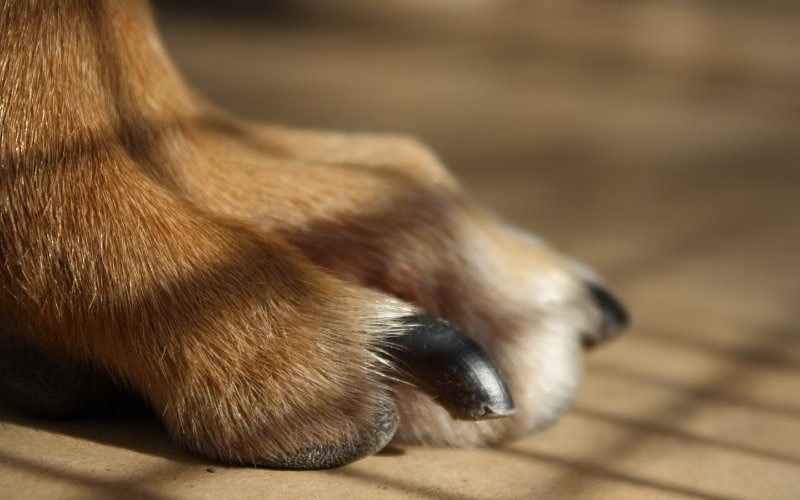
Click to Skip Ahead
For many pet owners, trimming a dog’s nails is a tricky and stressful experience for both owner and dog. But making sure their nails, toes and feet are in tip-top shape is an important part of pet ownership.
Fortunately, there are several options to keep your dog’s nails trimmed, including guillotine pet nail clippers and nail grinding with a Dremel-like tool. Human clippers, however, are not the best choice for most dog nails. Here’s why.
Can I Use Human Nail Clippers to Trim My Dog’s Nails?
Human nail clippers may be appropriate for trimming puppy nails when they’re very young, which is often done to prevent injury to the mother while the puppies nurse. After that, however, it’s much harder to trim dog nails effectively with human nail clippers, and basically impossible with large breeds.
Dog’s nails become wider and tougher as they grow. Human nail clippers are not only the wrong shape for a dog’s nail, but they can easily hurt and damage your dog’s nails as you try to trim them, as you will probably end up squashing or crushing the nail rather than cutting them cleanly. If you have a tiny dog, like a small Chihuahua or Yorkshire Terrier, you may find that human toenail clippers work quite well, but in general, dog’s nails should be cut with dog nail clippers. Guillotine clippers or curved nail clippers are specially designed to cut cleanly through a dog’s nails and reduce risk and trauma.

Why Do Dogs Need Nail Trimming?
Your dog’s long, sharp nails don’t just cause a lot of clicking noise and damage to your furniture or floor. Having long nails can affect your dog’s health and mobility.
When nails get too long, they change your dog’s posture. They have to accommodate that extra length by rocking their weight back, which can put excess pressure on their joints. Sometimes, long nails will cause the foot to splay and reduce traction. Over time, this impacts the tendons and may cause deformed feet.
Long nails are more prone to injury as well. They can break or chip, causing pain and increasing the risk of infection. Excessively long nails can grow into the paw pad as well, which is painful for your dog and may leave them susceptible to infections in the skin.
Aside from the risks with long nails, they’re uncomfortable to walk on all the time. Leaving your dog’s nails long is the equivalent of walking on your fingernails. So, even if it’s stressful for your dog to get their nails trimmed, it’s an important part of responsible pet ownership.
How to Avoid Anxiety Over Nail Clipping
Some dogs get extremely stressed over nail clipping, whether it’s because the situation is new so they don’t know what is happening, or having previous bad experiences. It takes time and patience to get your dog comfortable with nail clipping, but it’s a good time investment to make things easier in the future.
This process is often easier with puppies, but any dog can be taught to tolerate nail clipping. The most important part of teaching your dog to feel okay about having their nails cut is to get them used to having their feet handled, without the nail clippers. If your dog is already quite anxious about having their feet touched, proceed gently, using treats and praise whenever they let you get a bit further. It might take several weeks to reach a point where they are happy with this, but it is time well spent.
Once your dog is happy for you to handle their paws, the next step is to take your time getting them used to the clippers or nail grinder. Here’s how to slowly acclimate your dog to nail trimming:
Taking it slow and making each step a positive experience is key to getting your dog comfortable with nail trims. Eventually, it will become a regular, anxiety-free experience.

How to Clip a Dog’s Nails
If you’ve never clipped a dog’s nails before, it’s best to get a lesson from your vet or vet tech. It can be challenging to know how far to clip, especially on dogs with dark nails.
First, choose your tools. As mentioned, human nail clippers are not appropriate. You can work with guillotine-style or curved nail clippers that are specifically designed for pets or a nail grinder like a Dremel tool. Each have their pros and cons, so it depends on which one is more comfortable for you and your dog. You should also have styptic powder on hand to stop the bleeding if you cut a nail too short.
If you prefer to use a nail grinder, follow steps 1 and 2. Then, instead of clipping just the tip of the nail, you will use the nail to gently file the bottom of the nail and the trim. The benefit of using a grinder is that you can take off small bits each time, making it clear where the quick starts so you can avoid it.
How Often Should You Cut a Dog’s Nails?
Most dogs need their nails trimmed every month or so, but this can vary. Some dogs have nails that grow a little faster, and some will naturally wear down their own nails walking on concrete. It’s best to check your dog’s nails regularly to see if the nails are getting long. Even if your dog naturally wears their nails with activity, you may still need to trim them to keep them smooth. In addition, the dew claw won’t get worn down and will need regular trimming.

How Short Should My Dog’s Nails Be?
It’s extremely important not to trim your dog’s nails too short. Generally, dog’s nails should be short enough that they are in line with the pad under the toe, but your vet can talk to you about the appropriate length for your dog and their lifestyle. Be aware that some dogs will have nails that still click on hard floors, even when they are the right length, so it is important to check with your vet that they do need cutting.
What If My Dog Still Gets Stressed About Having Their Nails Cut?
Some dogs will never be happy having their nails cut, and it is important to know when to call it quits, rather than cause too much stress. If you are in this situation, there are a few options to consider:

Conclusion
Trimming your dog’s nails can be stressful, but it doesn’t have to be. Taking the time to desensitize your dog and using the right tools (not human nail clippers) can go a long way toward making nail trimming a regular and stress-free part of your routine.
Featured Image Credit: Sahil S Mehta, Shutterstock









